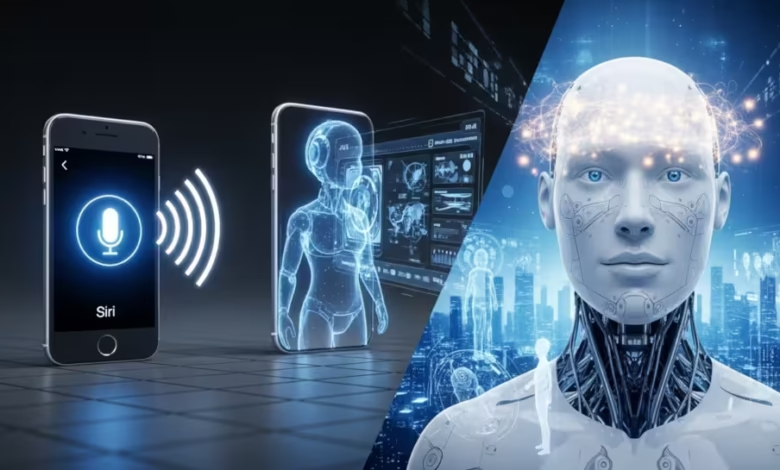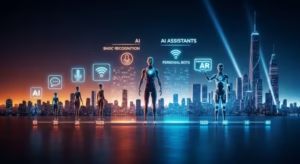The Evolution of AI Assistants: From Siri to Sentient Systems?

The blog post titled ‘The Evolution of AI Assistants: From Siri to Sentient Systems?’ explores the fascinating journey of AI assistants evolution. It begins by providing an overview of how AI assistants have developed, highlighting key milestones in their journey. The article dives deeper into the impact of voice AI innovations, showcasing how they have transformed interaction patterns between users and technology. Furthermore, it discusses the emergence of personal AI bots that are revolutionizing user experience by offering tailored and intelligent solutions. Concluding with key takeaways, the post reflects on future directions in AI assistant evolution, emphasizing the potential for even more advanced systems. This comprehensive examination underscores the rapid advancements in AI assistants and their pivotal role in shaping user interactions in today’s digital landscape.
The Journey Of AI Assistants: An Overview

The evolution of AI assistants has transformed how we interact with technology, making smart assistants an integral part of our daily lives. Beginning as simple voice recognition systems, AI assistants have progressed into sophisticated entities capable of understanding context, learning from user behavior, and even exhibiting introductory forms of emotional intelligence. This AI assistants evolution reflects a broader trend towards integrating artificial intelligence into everyday applications, enhancing not only convenience but also functionality.
Key Stages In The Evolution Of AI Assistants
- Early Voice Recognition (1960s-1980s): Initial attempts at AI focused on basic voice commands.
- Rule-Based Systems (1990s): Implementation of predefined rules to enhance user interactions.
- Natural Language Processing (NLP) (2000s): Introduction of NLP techniques allowed assistants to understand and process human language more effectively.
- Smartphone Integration (2010): The launch of Siri marked a pivotal moment, popularizing AI assistants in consumer technology.
- Machine Learning Advancements (2015): AI assistants began using machine learning to improve accuracy and personalization.
- Multi-Modal Interactions (2020): Evolution towards incorporating gestures, facial recognition, and voice in user interactions.
- Sentient-like Capabilities (Future): The ongoing research into developing AI with emotional intelligence and deeper understanding.
The current landscape of AI assistants exhibits a remarkable blend of innovation and user-centric design. As smart assistants advance, they are set to reshape user experience, making interactions more intuitive and tailored. The journey of AI assistants is far from over; rather, it is a continuum that will likely pave the way for even more advanced technologies. As we look toward the future, understanding this AI assistants evolution will be pivotal in exploring the fascinating potential of these systems.
Diving Deeper: The Impact Of Voice AI Innovations

The rapid advancements in voice AI technology have transformed the landscape of how we interact with machines. With the evolution of AI assistants transitioning from basic task performers to highly sophisticated conversational AI systems, the impact on user experience is profound. These innovations are not only refining the accuracy and responsiveness of AI assistants, but they are also reshaping the expectations and behaviors of users worldwide.
Voice AI is increasingly becoming a household staple, thanks to its integration into various devices such as smartphones, smart speakers, and home automation systems. The natural language processing capabilities of these AI assistants enable seamless interactions, which significantly enhance user satisfaction. As a result, organizations are now prioritizing voice AI integration as a key component of their digital strategies, marking a pivotal shift in the customer engagement landscape.
| Feature | Voice AI | Conversational AI |
|---|---|---|
| Functionality | Speech recognition, basic command execution | Contextual understanding, multi-turn conversations |
| Use Cases | Weather updates, music playback | Customer service, personalized recommendations |
| User Experience | Quick responses, limited interactivity | Engaging interactions, enhanced personalization |
Integrating these advanced systems requires a careful understanding of user needs and behaviors. Companies that leverage voice AI effectively can create more user-friendly environments that cater to individual preferences. Additionally, the rise of multi-modal interactions—where voice interfaces complement visual interfaces—offers a richer and more versatile user experience.
Stages Of Voice AI Development
- Basic voice recognition systems
- Simple command execution functionality
- Introduction of contextual voice processing
- Development of multi-turn conversational capabilities
- Integration with other digital services and ecosystems
- Emergence of personalized voice assistants
- Full-fledged conversational AI with emotional intelligence
Technological Advances
One of the most significant technological advances in voice AI is the incorporation of machine learning algorithms that enable these systems to learn from user interactions. This not only improves the accuracy of responses but also allows AI assistants to adapt to specific user preferences over time. Furthermore, innovations in cloud computing have enhanced the processing power available to these devices, enabling complex tasks to be solved quickly and efficiently.
User Interaction Enhancements
As voice AI continues to evolve, user interactions are becoming more engaging and personalized. The ability to recognize different voices, dialects, and languages empowers AI assistants to provide tailored experiences, significantly increasing user satisfaction. Ultimately, the fusion of voice AI and conversational AI is pushing the boundaries of traditional human-computer interaction, paving the way for future innovations that will make technology more intuitive and accessible for everyone.
How Personal AI Bots Are Revolutionizing User Experience

The evolution of AI assistants has significantly transformed how users interact with technology. Today, personal AI bots are at the forefront of this evolution, offering a level of customization and interactivity that traditional smart assistants could not provide. These advanced systems leverage machine learning and natural language processing to better understand user preferences, thus creating a more seamless and personalized user experience.
Benefits Of Using Personal AI Bots
- Increased personalization based on user behavior
- Enhanced efficiency in task management
- Improved communication and interaction
- 24/7 availability for support and assistance
- Streamlined workflows through automation
- Data-driven insights for informed decision-making
The integration of these innovative personal AI bots into various industries has proven to be beneficial not only for end-users but also for businesses. By automating routine tasks and delivering tailored solutions, organizations can enhance productivity and customer satisfaction. Moreover, the continuous learning capabilities of these smart assistants allow them to adapt over time, further enriching the user experience.
Ultimately, the future of AI assistants evolution is bright, with personal AI bots poised to redefine user interaction in ways we have yet to fully realize.
As we look ahead, the advancement in AI technology suggests that personal AI bots will keep evolving, potentially integrating even more complex functionalities. This evolution will likely consolidate their role as essential tools in our daily lives, bridging the gap between humans and machines through engaging, interactive experiences.
Key Takeaways And Future Directions In AI Assistant Evolution

The AI assistants evolution has been a remarkable journey, transitioning from simple voice recognition systems like Siri to more advanced conversational AI that can understand context and emotions. As we look forward to the future, it is essential to recognize the pivotal shifts that have occurred in this field. AI assistants are no longer just tools for performing tasks; they are becoming integral companions in our daily lives, enhancing both personal and professional experiences. The challenge lies ahead in fine-tuning these systems to ensure they are not only functional but also ethical and reliable in their interactions.
Next Steps For Users Interested In AI Assistants
- Research different AI assistants to find one that fits your needs.
- Experiment with various features to maximize usability.
- Stay informed about updates and new functionalities in the market.
- Provide feedback to developers to help enhance AI performance.
- Engage with online communities to exchange tips and experiences.
- Consider privacy settings to protect your data.
- Explore integrations with other smart devices for a seamless experience.
As AI assistants continue to evolve, the focus on improving their conversational abilities will be paramount. The integration of conversational AI technologies allows for more human-like interactions, creating a stronger bond between users and their digital assistants. Ultimately, the future of AI assistance will rely on developing systems that are not just reactive but also proactive, anticipating user needs and preferences while maintaining a strong ethical foundation.
Briefing Document: The Evolution of AI Assistants
I. Introduction
This briefing document summarizes the key themes, ideas, and facts presented in the source “The Evolution of AI Assistants: From Siri to Sentient Systems? – The Future of Artificial Intelligence.” The article provides a comprehensive overview of the progression of AI assistants, from their nascent stages of voice recognition to the potential for future sentient-like capabilities, highlighting their transformative impact on user interaction and the digital landscape.
II. Main Themes and Most Important Ideas/Facts
The source emphasizes several core themes:
A. The Journey of AI Assistants: A Continuous Evolution
The article highlights the significant progression of AI assistants, emphasizing that their development is an ongoing process rather than a static endpoint. They have evolved “from simple voice recognition systems” to “sophisticated entities capable of understanding context, learning from user behavior, and even exhibiting introductory forms of emotional intelligence.” This evolution is characterized by several key stages:
- Early Voice Recognition (1960s-1980s): Focused on “basic voice commands.”
- Rule-Based Systems (1990s): Introduced “predefined rules to enhance user interactions.”
- Natural Language Processing (NLP) (2000s): Enabled assistants to “understand and process human language more effectively.”
- Smartphone Integration (2010): Marked by “The launch of Siri [which] popularized AI assistants in consumer technology.”
- Machine Learning Advancements (2015): Led to AI assistants “using machine learning to improve accuracy and personalization.”
- Multi-Modal Interactions (2020): Incorporated “gestures, facial recognition, and voice in user interactions.”
- Sentient-like Capabilities (Future): Represents “ongoing research into developing AI with emotional intelligence and deeper understanding.”
The article stresses that this journey is “far from over; rather, it is a continuum that will likely pave the way for even more advanced technologies.”
B. The Profound Impact of Voice AI Innovations
Voice AI is presented as a transformative force, profoundly impacting user experience by enabling “seamless interactions” and leading to “organizations now prioritizing voice AI integration as a key component of their digital strategies.” Key aspects include:
- Shift to Conversational AI: Voice AI has transitioned “from basic task performers to highly sophisticated conversational AI systems.”
- Enhanced Functionality: While basic voice AI offers “Speech recognition, basic command execution,” conversational AI provides “Contextual understanding, multi-turn conversations.”
- User Interaction Enhancements: “The ability to recognize different voices, dialects, and languages empowers AI assistants to provide tailored experiences, significantly increasing user satisfaction.”
- Technological Advances: The incorporation of “machine learning algorithms” allows systems to “learn from user interactions” and adapt, while “innovations in cloud computing have enhanced the processing power.”
- Multi-modal Interactions: The rise of “multi-modal interactions—where voice interfaces complement visual interfaces—offers a richer and more versatile user experience.”
C. Personal AI Bots: Revolutionizing User Experience through Personalization
Personal AI bots are identified as the “forefront of this evolution,” offering “a level of customization and interactivity that traditional smart assistants could not provide.” Their revolutionary impact stems from:
- Increased Personalization: Bots leverage “machine learning and natural language processing to better understand user preferences, thus creating a more seamless and personalized user experience.” This includes “Increased personalization based on user behavior.”
- Enhanced Efficiency and Support: They offer “Enhanced efficiency in task management,” “24/7 availability for support and assistance,” and “Streamlined workflows through automation.”
- Continuous Learning: “The continuous learning capabilities of these smart assistants allow them to adapt over time, further enriching the user experience.”
- Future Redefinition of Interaction: The article posits that “Ultimately, the future of AI assistants evolution is bright, with personal AI bots poised to redefine user interaction in ways we have yet to fully realize.”
D. Future Directions and Ethical Considerations
The future of AI assistants is envisioned as moving towards more sophisticated, proactive, and ethically grounded systems.
- Integral Companions: AI assistants are “becoming integral companions in our daily lives, enhancing both personal and professional experiences.”
- Focus on Conversational Abilities: “The integration of conversational AI technologies allows for more human-like interactions, creating a stronger bond between users and their digital assistants.”
- Proactive and Ethical Systems: The future will “rely on developing systems that are not just reactive but also proactive, anticipating user needs and preferences while maintaining a strong ethical foundation.”
- User Engagement and Privacy: Users are encouraged to “Stay informed about updates and new functionalities,” “Provide feedback to developers,” and “Consider privacy settings to protect your data.”
The source paints a dynamic picture of AI assistants, showcasing their past advancements, current capabilities, and exciting future potential. The evolution from basic voice commands to sophisticated conversational and personal AI bots underscores a fundamental shift in how humans interact with technology. The emphasis on personalization, contextual understanding, and multi-modal interactions highlights the ongoing drive to make AI assistants more intuitive, efficient, and deeply integrated into daily life, with an increasing focus on ethical development and user experience.
Homepage / humanaifuture.com
For similar articles, please visit: / AI in Science & Technology
🎧 Listen to the Podcast
Want to explore this topic in more depth? Listen to the full podcast for more insights and expert commentary.
▶️ Play on Google DriveNo sign-up needed — just click and listen.
What is the impact of voice AI innovations on user experience?
Voice AI innovations have profoundly reshaped user interaction with machines, moving beyond basic task performance to highly sophisticated conversational AI systems. These advancements have refined the accuracy and responsiveness of AI assistants, making them a household staple integrated into smartphones, smart speakers, and home automation. They enable seamless interactions through natural language processing, significantly enhancing user satisfaction and prompting organizations to prioritize voice AI as a key digital strategy. The fusion of voice AI with conversational AI is pushing the boundaries of human-computer interaction, making technology more intuitive and accessible.
What are the key differences between Voice AI and Conversational AI?
Voice AI primarily focuses on speech recognition and basic command execution, serving use cases like weather updates or music playback. It offers quick responses but has limited interactivity. Conversational AI, on the other hand, boasts contextual understanding and multi-turn conversational capabilities. Its use cases extend to customer service and personalized recommendations, providing engaging interactions and enhanced personalization. While Voice AI forms the foundation, Conversational AI represents a more advanced stage that allows for more human-like and dynamic interactions.
How do personal AI bots revolutionize user experience?
Personal AI bots are at the forefront of AI assistant evolution, offering a significantly higher level of customization and interactivity compared to traditional smart assistants. They leverage machine learning and natural language processing to deeply understand user preferences, leading to a more seamless and personalized user experience. These bots provide increased personalization, enhanced efficiency in task management, improved communication, 24/7 availability, streamlined workflows through automation, and data-driven insights. Their continuous learning capabilities allow them to adapt over time, enriching the user experience and promising to redefine user interaction in the future.
What technological advances have driven the evolution of AI assistants?
Key technological advances include the incorporation of machine learning algorithms, which enable AI systems to learn from user interactions, thereby improving response accuracy and adapting to specific user preferences over time. Innovations in cloud computing have also significantly enhanced the processing power available to these devices, allowing them to solve complex tasks quickly and efficiently. These advancements, coupled with improvements in natural language processing, have been crucial in the progression from simple voice recognition to sophisticated conversational AI and personal AI bots.
What are the future directions for AI assistant evolution?
The future of AI assistant evolution will primarily focus on improving their conversational abilities, aiming for more human-like interactions and creating stronger bonds between users and their digital assistants. The goal is to develop systems that are not just reactive but also proactive, capable of anticipating user needs and preferences. This progression also emphasizes the importance of maintaining a strong ethical foundation, ensuring that these advanced systems are reliable and trustworthy in their interactions. The ultimate aim is for AI assistants to become integral companions in daily life, enhancing both personal and professional experiences.
What are some practical steps users can take to engage with AI assistants?
For users interested in AI assistants, it's recommended to research different options to find one that aligns with their needs. Experimenting with various features can maximize usability, and staying informed about updates and new functionalities is crucial. Providing feedback to developers can help enhance AI performance. Engaging with online communities can facilitate the exchange of tips and experiences, and critically, users should consider privacy settings to protect their data. Exploring integrations with other smart devices is also advised for a more seamless experience.
What is the ultimate goal of AI assistant development?
The ultimate goal of AI assistant development is to create systems that are not merely functional tools but rather integral, intelligent companions capable of understanding context, learning from user behavior, and even exhibiting introductory forms of emotional intelligence. This evolution aims to provide tailored and intelligent solutions that enhance convenience, functionality, and overall user experience, ultimately bridging the gap between humans and machines through engaging, interactive, and personalized interactions. The long-term vision even includes the development of "sentient-like capabilities."




